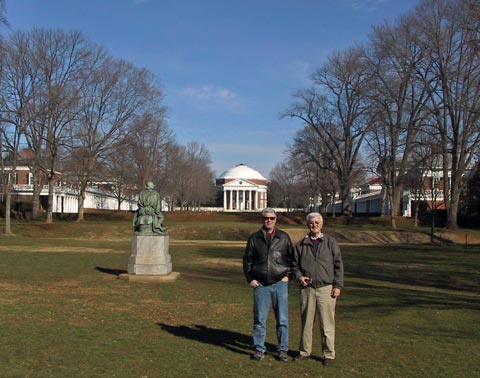
University of Virginia, me and my father
Whenever I vist Williamsburg, Virginia–where I grew up–I always think about the presence of architecture exhibited in the mostly modest structures that were built there in the 18th century. The way in which ideas of a new civilization were carved into the wilderness. The most important of Virginia’s early architects was, undoubtedly, Thomas Jefferson. He did not build anything in Williamsburg, where he served in the House of Burgesses, the parliament of colonial Virginia, but carried his ideas west to his own home, Monticello, the Virginia State capital in Richmond, and ultimately, the University of Virginia campus. Both my father and I went to UVA, and though I didn’t complete a degree there, I know the place well.
Upon returning to New York, I came across the American Institute of Architects poll “America’s Favorite Architecture,” and was shocked to find Jefferson’s campus missing from the 150 buildings listed–as was Louis Kahn’s Salk Institute in California, but that’s another story. I have traveled fairly widely, at least in Europe and the US, and have seen many of the world’s significant structures. Sometimes, I have had to warm up to certain buildings, walk around them, go inside, approach from different angles. As an architectural photographer I tend to stalk buildings, creep up on them, or try to surprise myself with an unexpected glance of the familiar. But sometimes, a building or a place will thrill me the first time around: the Parthenon, Corbusier’s Ronchamp chapel, Wright’s Falling Water (also not on the list), Mendelsohn’s Einstein Tower, Rockefeller Center, Gaudi’s Casa Mila, just to name some prominent ones.
After having seen all these other great buildings I still find Jefferson’s “academical village” one of the purest expressions of conceptual idealism in the world. Its design elements quote Roman and Greek classicism–the Rotunda is directly based on the Pantheon–while the organization of the space encourages the democratic interaction of professors and students. On the one hand, the space of the lawn creates an embracing enclosure, and on the other hand the lawn’s expanse leading to a view of the adjacent mountains opens this sanctuary of learning out to the world. The open end of the lawn was misguidedly closed off years ago, but the overall effect is only partially diminished.
I was not surprised to find that Americans favored older buildings, important icons, and emotionally or politically charged symbols like the World Trade Center. I, too, would place the Empire State Building up high on my list. But to completely miss what is arguably the greatest architectural work on the continent–among the finest in the world–designed by Thomas Jefferson, writer of the Declaration of Independence, is just unthinkable.